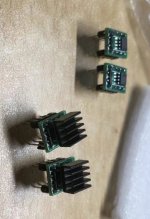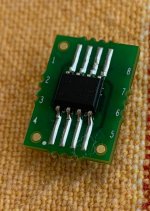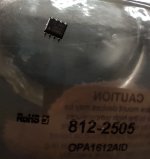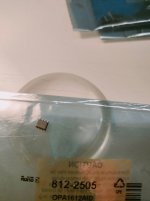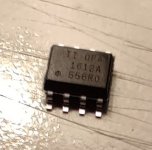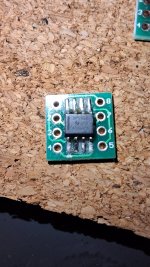And even those heatsinks are not enough for high quiescent current at +/-15V. That 200mA figure is probably based on peak output current. If we look at the Whammy preamp, and those big coolers needed for 60mA quiescent current, everything is clear. In my opinion, A class or AB class is less important if it sounds good. The opamp is definitely class AB unless the mosfets are on the output with their huge input impedance. For the higher resistance of the next stage, which is usually 10k or more, it will probably always be in A class. For headphones 32ohm it will work in AB.
Last edited:
I use a flat soldering tip for SMD, which I have been using for years quite successfully. I have a hot blow gun for desoldering SMD parts. It all goes easily and quickly, and the joints are flawless. Flux leftover is easily washed off with Isopropyl alcohol. I see no reason to do otherwise.There's no reason for either of those.
Add solder to one of the corner pads. Heat up the solder and set the IC down into it. Make sure it's centred properly on the footprint. Then solder the remaining pins. Solder already has flux in it and there's really no need for more.
If you do drown the part in flux, make sure you clean it off after if you want the full performance.
Tom
I tried the OPA1611/1612 a long time ago and it is a good opamp. Leans a little on the bright side. The OPA1622 has a higher allowable output current, but for some reason it doesn't sound as good to me as 1611/12. It is very small, so it is not easy to solder it. It requires additional elements to function, and there is no single version. The OPA1655/56 (FET inputs) has a slightly fuller sound than 1611/12 and is my favorite.
https://www.audiophonics.fr/en/opa/opa1622-dual-opa-dip8-unit-p-12489.html
https://www.audiophonics.fr/en/opa/opa1622-dual-opa-dip8-unit-p-12489.html
Last edited:
I would just add, about the opamp rolling. The OPA1611/12 are fast (27V/µs), high GB opamps (40MHz), as are many others mentioned. I have had problems with insufficient frequency compensation or true oscillation in some circuits. The function generator and oscilloscope are highly recommended to check what's going on. NE5532 have 9V/μs &10MHz and significantly less chance of oscillation. The NE5534 is not internally compensated enough, and without additional external compensation it can oscillate at a voltage gain of less than 3x . It is otherwise identical to 5532. So caution is needed with such games.
Last edited:
I have built Miro DACs (AD1862, AD1865, PCM1702, PCM63, PCM56) and 1655/56 performed very well with 1702 and AD1865 in I/V assembly. Sparkos SS3602 was a little better, but many times more expensive. I also tried Muses 02, then Bursons (V5, V6 classic, V6 Vivid, V7 Classic) and various of these factory opamps (NE5532, OPA604/2604, OPA1641/42A, LME49710/20 and some others), even some Chinese discreet ones. I also made a few Whammy headamps and several line preamps, where the opamps behave a little differently. But for some good cheap opamp, I always recommend the 1655/56. Currently my best score with AD1862 DAC is Sparkos. It's all subjective of course, in my system. There will surely be another favorite somewhere else. A lot depends on the rest of the equipment and personal feelings of what is good and what is not. As for the NE5532/34, the old Signetics sound a lot better than the newer TIs, especially the latest ones. That opamp has been changing internally for decades, unfortunately not for the better sound.
Last edited:
I prefer opa134 , it lacks the resolution but it gives more enjoyment and is fatigue free..
I have a cathode feedback torridly output transformers in pentode mode and it is too bright with it, my headphones as well
I have a cathode feedback torridly output transformers in pentode mode and it is too bright with it, my headphones as well
Except that the heatsink is on the wrong device! Hilarious!Some random pics I found online, heatsink mounted.
View attachment 1459666
Jan
I did quite a few amp rolling since a few decades, always taking care that the op amps were suited to the design they fitted in of course.
When appropriate, OPA1611 / 1612 really amazed me. In my test rig, it is as transparent as it gets. I daisy chained / included 2 stages "for nothing" in a loop in my system and couldn't hear them. Their transparency and speed is addictive and so enjoyable.
Having said that, my current favourite is OPA 1655 / 1656, depite my love for AD op amps. It is nearly as transparent as OPA1611 / 1612 while being a bit euphonic, having that special PRAT sense. More fun and more long term enjoyable, unless your system is already say very euphonic or rounded off.
I have no need for a DAC, but I would have loved to open again my flavour box (lots of op amps already mounted for compatibility, ready to go). I played with the idea of putting 2 x OPA1612 and 1x OPA1656 (or whatever other combo depending on my findings) inside say a Fosi ZD3 and use the RCA output (as that one would go through all op amps despite... what the manufacturer advertises LOL).
Great op amps, better then the best we had 3 decades ago - despite biasing in Class A and other tricks.
The world has moved on... I moved from hater to believer 🙂
All IMHO
Claude
PS: I exchanged long time ago here with John, who designed OPA1656, and wondered why it didn't benefit (on the contrary in fact) from Class A biasing. It is in its design: biasing OPA1656 is a bad thing unless you love some extra bass distorsion. Can't comment on OPA 1611 /1612, but I hope someone here checked that biasing it in Class A would make sense...
When appropriate, OPA1611 / 1612 really amazed me. In my test rig, it is as transparent as it gets. I daisy chained / included 2 stages "for nothing" in a loop in my system and couldn't hear them. Their transparency and speed is addictive and so enjoyable.
Having said that, my current favourite is OPA 1655 / 1656, depite my love for AD op amps. It is nearly as transparent as OPA1611 / 1612 while being a bit euphonic, having that special PRAT sense. More fun and more long term enjoyable, unless your system is already say very euphonic or rounded off.
I have no need for a DAC, but I would have loved to open again my flavour box (lots of op amps already mounted for compatibility, ready to go). I played with the idea of putting 2 x OPA1612 and 1x OPA1656 (or whatever other combo depending on my findings) inside say a Fosi ZD3 and use the RCA output (as that one would go through all op amps despite... what the manufacturer advertises LOL).
Great op amps, better then the best we had 3 decades ago - despite biasing in Class A and other tricks.
The world has moved on... I moved from hater to believer 🙂
All IMHO
Claude
PS: I exchanged long time ago here with John, who designed OPA1656, and wondered why it didn't benefit (on the contrary in fact) from Class A biasing. It is in its design: biasing OPA1656 is a bad thing unless you love some extra bass distorsion. Can't comment on OPA 1611 /1612, but I hope someone here checked that biasing it in Class A would make sense...
Last edited:
Frankly, I'd rather buy these boards w/o the opamp, so i can source opamps from reputable vendors and solder them on myself. Potentially chips i already have on hand.
opa16xx do seem to be a pretty good series. I've used 1656 and 1612 in a couple projects, on DIP adapter boards with bypass capacitors, and I've been pretty pleased. I have some 1642 still in the heat-sealed static bag from mouser w/ the desiccant pack and moisture indicator.
As for oscillation, some chips are more stable than others. I wholeheartedly agree that total speed demon chips shouldn't be used on adapters, or without some careful design considerations. But I'm not sure the 1611/1612 or 1656 are in that category.
opa16xx do seem to be a pretty good series. I've used 1656 and 1612 in a couple projects, on DIP adapter boards with bypass capacitors, and I've been pretty pleased. I have some 1642 still in the heat-sealed static bag from mouser w/ the desiccant pack and moisture indicator.
As for oscillation, some chips are more stable than others. I wholeheartedly agree that total speed demon chips shouldn't be used on adapters, or without some careful design considerations. But I'm not sure the 1611/1612 or 1656 are in that category.
All mentioned opamps are unity gain stable, so it won't oscillate. However, when the schematic is expanded with an additional output stage, this may change. I have published here on the forum the results for one copy of the Whammy headamp. Various opamps, various compensations and anti-oscillation measures. Some opamps work without the need for interventions. In my Whammy headamp, so far the OPA2604, NE5532 Signetics and Burson V7 Classic work without problems. I just take one out and stick the other in. When I move on to other opamps, I'll definitely need to play around. On the previous copy, it was the 1612 that gave me the most problems with wild oscillation (and it is not from China, and the adapter is BrownDog). 🤣
Last edited:
good morning guys, for information purposes, I send some pictures of the ORIGINAL Texas Instruments OPA1612 ( seller RS). Un saluto to everyone. Ros
Attachments
even viewing it live with magnifying glasses you can't distinguish the logo (it looks like a mix between Hitachi and Texas Instruments 🙂: but I confirm : it is genuine 100%
- Home
- Amplifiers
- Chip Amps
- OPA1611 from eBay
